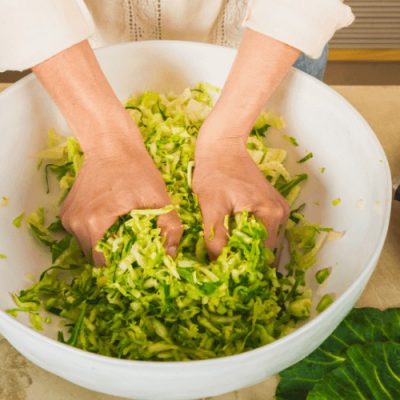
I first learned about making fermented veggies in Nourishing Traditions. If you have been learning about health and wellness for a while, I bet you have heard about Sally Fallon and her classic book.
Traditional Diets
Sally Fallon is the president of the Weston A. Price Foundation. Even though the foundation promotes the use of grains and baked goods as long as they are properly fermented (soaked), I recommend you check out the Website, it is filled with fascinating information. As I mentioned before, I try to avoid grains because I feel better without them, but I don’t believe they are inherently bad for you. We can learn a lot from traditional cultures and the way they eat. In fact, this is exactly what Weston Price did in his fascinating book Nutrition and Physical Degeneration. He traveled the world and found peoples who had been untouched by industrialization. They were eating the way the did thousands of years ago and had beautiful straight teeth, strong jaws
The Importance of Fermented Foods
Fermented veggies are not only a great way to preserve the abundance from your garden, but they also provide incredible health benefits. The fermenting process creates good bacteria that feed your gut. Moreover, it improves the nutritional benefits of certain foods.
Fermented vegetables help improve your gut health
Gut health seems to be a buzzword these days, but it is scientifically proven to affect pretty much every aspect of your health. Look it up on PubMed if you are skeptical.
etter gut health will not only improve your intestinal health, but also your immune function, your cognitive health, and your mood.
However, it isn’t just about gut health. Fermented vegetables do so much more or you.
Fermented vegetables can be more nutritious
The fermenting process actually improves the nutritional profile of some veggies. For example, cabbage contains roughly 30 mg of vitamin C per cup. But red cabbage sauerkraut can contain as much as 700 mg per cup!

The Benefits of Sauerkraut
The benefits of fermented vegetables have been vastly studied. Before writing this post, it never occurred to me that some scientists out there spent time looking at the health benefits of sauerkraut for example.
This particular study summarizes the benefits of sauerkraut. The results showed how sauerkraut was effective for detoxification and general health. It was found to be antioxidant, anti-carcinogenic and anti-inflammatory.
How to Ferment Veggies
I am sure you are convinced by now and you are looking forward to getting started. Over the years, I have tried many fermentation methods. The one you will find below is as simple as can be and the results are pretty much foolproof.
In the book Nourishing Traditions, you will learn to ferment your veggies through the lacto-fermentation process. All it means is, that you are adding some whey as a starter culture. However, we have been completely dairy-free, so I do not use whey. Instead, you can simply add more salt (about 1-2 Tbsp per quart of fermented veggies). Here’s what you will do:

Fermented Vegetables
Ingredients
- 1 cabbage or an assortment of sliced/chopped veggies like carrots, cucumbers, ginger, garlic
- 2-4 Tbsp sea salt or Himalayan salt
- enough water to cover
Instructions
- If you are using cabbage, sprinkle your salt over the shredded cabbage and pound until the juices start coming out.
- If you are using other veggies, mix your salt in water instead. Add 1-3 Tbsp of salt per quart of water.
- Pack your shredded cabbage or your sliced veggies in 1-quart Mason jars. When packing down the cabbage, press it as much as possible. You should see the juices coming up.
- Add water as need. If you are using shredded cabbage, add water only if you need to. You should have about an inch of water at the top of your veggies. Also, you need to leave about 2 inches of space between the lid and the water. If you are using sliced veggies, simply add your saline water.
- Cover loosely (do not screw on the tops) and let sit on your counter for at least 3 days.
- Transfer to the fridge when ready.
Notes

We talked about lacto-fermented vegetables, but there is something else you can do. You can use a special lid for your Mason jar. These lids are specifically designed for fermentation and they ensure that no oxygen gets to your veggies, which would spoil them. You can purchase these lids on Amazon. I ended up finding that it didn’t make a difference and my veggies turned out fine without them.
How long should you ferment your veggies?

Really, it all depends on your preference. The longer you ferment, the stronger it will taste. The average is probably between 3 to 7 days. Some strains of healthy bacteria will take longer to populate, so some recommend to leave it on the counter for 3 weeks.
In fact, it is said that purists recommend you let it sit for no less than 3 weeks.
As for me, that is what I am planning to try next time. I don’t think I have fermented my veggies for more than a week so far. What about you? Would you leave it for that long?





